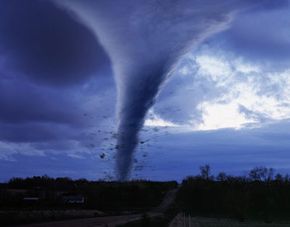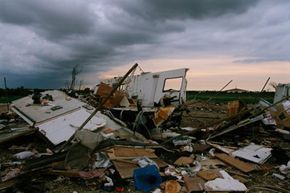By: Charles W. Bryant

Dorothy Gale and Toto might be able to tell you. Same with Bill Paxton and Helen Hunt. But aside from in "The Wizard of Oz" and "Twister," has anyone ever been in the eye of a tornado and lived to tell about it? It seems that a couple of people have -- a man in 1928 and another in 1943. We'll get to them next, but first, let's get into these tornadoes ourselves and see what all the fuss is about.
We all know what tornadoes look like, but what are they? The American Meteorological Society's official definition is "a violent rotating column of air, in contact with the ground, either pendant from a cumuliform cloud or underneath a cumuliform cloud, and often (but not always) visible as a funnel cloud" [source: American Meteorological Society].
Advertisem*nt
A tornado forms as a thunderstorm approaches. In the lower atmosphere, increased wind speeds create a horizontal but invisible spinning tube. Once the storm rumbles through, rising air tilts this tube from its horizontal position to the more recognizable vertical funnel shape. From there, tornadoes can have wind speeds up to 300 mph and cause a great deal of destruction where they touch the Earth. They uproot trees, flatten houses and send cars flying through the air like Frisbees. The sound is often described as a freight train barreling through your home. You can learn more about tornadoes and how they're rated in How Tornadoes Work.
So if a tornado can fling a car and turn a house into toothpicks, how in the world can anyone survive standing in the eye of the beast and what's it like in there? We'll get two firsthand accounts next.
Advertisem*nt
Will and Roy's Big Adventures: Inside the Tornado

As far as we can tell, there are only two people on record that claim to have been in the center of a tornado and lived. Not surprisingly, both of them were farmers. The first man was Will Keller, from Greensburg, Kan.
On June 22, 1928, Mr. Keller was with his family, checking out the damage to his wheat crop from a hailstorm that had just passed. He spotted an umbrella-shaped cloud in the near distance and had a feeling that a tornado might develop. Before he knew it, there were three funnel clouds heading his way in a hurry. Keller rushed his family to their storm cellar and, before climbing in himself, decided to take another look. He'd seen many tornadoes over the years, so he wasn't afraid, but remained cautious. Kellar said he was transfixed by the twister, and he held his position until it was directly overhead.
Advertisem*nt
Once inside the swirling cloud, Keller said that everything was "as still as death." He reported smelling a strong gassy smell and had trouble breathing. When he looked up, he saw the circular opening directly overhead, and estimated it to be roughly 50 to 100 feet in diameter and about a half a mile high. The rotating cloud walls were made clearly visible by constant bursts of lightning that "zigzagged from side to side." He also noticed a lot of smaller tornadoes forming and breaking free, making a loud hissing noise. The tornado then passed, skipping over his house and smashing the home of his neighbor.
The second account from Roy Hall does nothing to disprove Keller's story. Hall was a soybean farmer in McKinnet, Texas. One spring afternoon in 1951, Hall and his family were outside when a nasty storm approached. He sent his wife and kids inside to hide under a bed but stayed to watch the coming storm. He claims to have seen green sheets of rain just before the tornado formed. After baseball-sized hail started coming down, he went inside. He then heard a loud rumbling followed by complete silence. The walls began to shake, and to his surprise, his roof was ripped away and thrown into the woods nearby. At this point, he looked up to find the tornado directly overhead. He described the inside as a smooth wall of clouds, with smaller twisters swirling around the inside before breaking free. Once again, non-stop lightning created a bluish light, enabling him to see everything clearly. And then, just like that, the tornado passed and the sky turned sunny. The same storm killed 100 Texans, but Hall and his family survived.
For more information on all things weather, please follow the yellow brick road for more links.
Tornado Facts
[source: NOAA]
- The low pressure of a tornado doesn't cause buildings to explode -- most damage comes from flying debris.
- Tornadoes occur most often between 3 and 9 p.m.
- Three out of four tornadoes touch down in the United States.
- The forward speed of a tornado can hit 70 mph.
- Opening the windows of your home does not help the wind pass through -- it actually causes more destruction.
- 800 tornadoes a year are reported in the U.S.
Advertisem*nt
Tornado FAQs
Is it possible to survive inside a tornado?
Some people have been caught inside one and lived to tell the tale, so while it's possible, it isn't likely.
Is it possible to breathe inside a tornado?
The region inside a tornado is called the "death zone," and is characterised by low temperatures and oxygen levels, making it difficult to breathe.
What happens if you go inside a tornado?
People and objects can get picked up before being dropped. Because this happens from a height, some manage to survive, but others aren't so lucky.
Is the inside of a tornado calm?
Evidence suggests that tornadoes mostly have calm, clear centers that have very low pressure.
Why is the center of the tornado so dangerous?
For someone trapped inside a tornado, they should be able to see a circular opening at the top that is about 50 to 100 feet wide, and around half a mile in height. The "funnel" is so because of rotating cloud walls. Also visible are frequent lightning bursts, and smaller tornadoes that build up before separating.
Lots More Information
Related HowStuffWorks Articles
- How Hurricanes Work
- How Emergency Power Systems Work
- How Floods Work
- How Wildfires Work
- How Lightning Works
- How Tornadoes Work
- What is a Nor'easter?
- Why are waves on west coast bigger than waves on the east coast?
- Why do hurricanes follow such peculiar tracks?
- What is a levee?
More Great Links
Sources
- American Meteorological Society, 2008. http://amsglossary.allenpress.com/glossary/search?id=tornado1
- Allen, Jean. "Tornadoes." Capstone Press, 2001.
- Justice, Alonzo A. "Seeing the Inside of a Tornado." noaa.gov, 2008. http://www.history.noaa.gov/stories_tales/inside_tornado.html
- "Tornadoes: Nature's Most Violent Storms." noaa.gov, 2008. http://www.nssl.noaa.gov/edu/safety/tornadoguide.html
Cite This!
Please copy/paste the following text to properly cite this HowStuffWorks.com article:
Citation
Advertisem*nt
Advertisem*nt
Loading...
\n\n\t\t\t\t
`;t.byline_authors_html&&(e+=`By: ${t.byline_authors_html}`),t.byline_authors_html&&t.byline_date_html&&(e+="|"),t.byline_date_html&&(e+=t.byline_date_html);var i=t.body_html.replaceAll('"pt','"pt'+t.id+"_");return e+=`\n\t\t\t\t
\n\t\t\t\t
\n\n\t\t\t\t
${i=i.replaceAll("#pt","#pt"+t.id+"_")}
\n\n\t\t\t
`}(a);this.loadedDiv.innerHTML+=n,document.title=a.title+" | HowStuffWorks";let s="content-loaded-"+a.id,l=document.getElementById(s);l.dataset.contentId=a.id;let o=l.querySelectorAll(".lazyload");HSW.utilities.lazyLoadElements(o),HSW.ux.editorial.init({twitter:!0,facebook:!0,instagram:!0}),l.querySelectorAll(".toc a").forEach(t=>{t.addEventListener("click",t=>{t.preventDefault();let e=t.target.dataset.target,i=document.querySelector("a[name='"+e+"']");i?i.scrollIntoView({behavior:"auto"}):console.error("Unable to locate target with name "+e)})});try{if(userData.adsActive)if(HSW.utilities.isMobile()){l.querySelectorAll(".ad-mobinline").forEach(t=>{t.setAttribute("id","ad-wrap-mobinline"+r),t.childNodes[0].setAttribute("id","ad-div-mobinline"+r),void 0!==HSW.ads&&HSW.pq.add(()=>{HSW.ads.addNewUnits(["ad-div-mobinline"+r])},"ads"),r++})}else{let t=document.createElement("div");t.setAttribute("id","ad-after-"+e),t.classList.add("ad-inline","mb-8","bg-gray","w-max-full","h-min-90","text-center");let a=document.createElement("div");a.setAttribute("id","ad-div-inline"+i),t.appendChild(a),l.after(t),void 0!==HSW.ads&&HSW.pq.add(()=>{HSW.ads.addNewUnits(["ad-div-inline"+i])},"ads")}}catch(t){console.error(t)}if(window.setupSinglePageUX(l),history.pushState)try{history.pushState(null,a.title+" | HowStuffWorks",a.href)}catch(t){console.warn(t)}var c=[];a.taxonomy.forEach((t,e)=>{c[e]=t.title.toLowerCase()});var d=c.join("/"),h=[];a.authors.forEach((t,e)=>{h[e]=t.first_name.toLowerCase()+" "+t.last_name.toLowerCase()});var g=h.join(",");pageMetricsData.href=a.href,pageMetricsData.title=a.title,pageMetricsData.tax=d,pageMetricsData.aType=a.asset_type,pageMetricsData.cType=a.type+"-continuous",pageMetricsData.template=a.template,pageMetricsData.source=a.source,pageMetricsData.sponsor=a.sponsor,pageMetricsData.author=g,pageMetricsData.contentid=a.id,pageMetricsData.image=a.hero_image,pageMetricsData.page=0,pageMetricsData.pubDate=a.publish_date.slice(0,10),pageMetricsData.editDate=a.last_editorial_date.slice(0,10);const u=/[^\da-z_]/i;let p=HSW.utilities.isMobile()?"hsw_lite":"hsw";a.taxonomy.slice(1,3).forEach((t,e)=>{p+="|"+t.title.replace(u,"").toLowerCase()}),pageMetricsData.adUnit=p,Alpine.store("share",{title:pageMetricsData.title,url:pageMetricsData.href,image:pageMetricsData.image}),function(t,e){let i=t.href.split(".com/").pop();dataLayer.push({event:"virtual-page-view",virtualPageUrl:i,virtualPageTitle:document.title,pageNbr:0}),dataLayer.push({event:"raw-event-interactive",eventCategory:"page-interaction",eventAction:"continuous-load",eventLabel:"new-content",eventValue:e+1,virtualPageUrl:t.href})}(a,this.items.length);const m={...pageMetricsData};t.items.push(m);for(var f=document.getElementsByClassName("new-content-loaded"),v=0;v